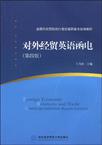对外经贸英语函电
2009-8
对外经济贸易大学出版社
王乃彦 编
318
本书(原名《外贸英语函电》)1982年出版发行,至今近30年来,经过多次修订改编,始终作为全国外经贸院校的外贸英语函电教材被广泛使用,普遍反映是一部好的外贸英语函电教科书。 此次改编的宗旨是:体现国际贸易中新的贸易方式,使教材实用性更强;体现国际贸易专业核心技能的培养,突出函电写作的能力训练;继续体现本教材编写认真严谨的特点,保证一贯的系统性和完整性。此次修订对各章节的信函、注释和练习均有更新;将代理、贸易方式等章节以附录的方式作为辅助材料供教师选择使用;系统介绍了目前国际贸易常用的通讯方式;同时加入了一套完整的业务案例,使读者了解一笔业务的全过程。 新的《对外经贸英语函电》共九章54课,附有四个附录。
THE LAYOUT OF A BUSINESS LETTERCHAPTER ONE ESTABLISHING BUSINESS RELATIONS Introduction Lesson 1 Self-Introduction Lesson 2 (A) A Request for the Establishment of Business Relations (B) A Reply to the Above Lesson 3 Status Enquiry Supplement Useful Sentences on Establishing Business RelationsCHAPTER TWO ENQUIRIES AND OFFERS Introduction Lesson 4 An Enquiry for Chinese Cotton Piece Goods Lesson 5 (A) An Enquiry for Iron Nails (B) A Reply to the Above Lesson 6 An Offer to a New Customer Lesson 7 A Finn Offer Lesson 8 A Voluntary Offer Lesson 9 A Special Offer Lesson 10 (A) Asking for Proforma Invoice (B) Sending Proforma Invoice Lesson 11 Urging the Buyer to Accept the Offer Lesson 12 Concession on Price Supplement Useful Sentences on Enquiries and OffersCHAPTER THREE MAKING COUNTER-OFFERS AND DECLINING ORDERS Introduction Lesson 13 Counter-Offer on Groundnut Kernels Lesson 14 Persuading the Buyer to Accept the Offer Lesson 15 Offering Substitute Lesson 16 Acceptance of a Counter-offer Lesson 17 Declining a Counter-offer Lesson 18 (A) A Repeat Order (B) Declining a Repeat Order Lesson 19 Partial Rejection of an Order Supplement Useful Sentences on Making Counter-Offers and Declining OrdersCHAPTER FOUR CONCLUSION OF BUSINESS Introduction Lesson 20 (A) Sending a Sales Contract (B) Sending a Sales Confirmation Lesson 21 Confirming a Purchase Lesson 22 Conclusion of Business Lesson 23 Counter-Signature Lesson 24 Confirming an Order Lesson 25 (A) Acknowledgement of the First Order (B) Confirrnation of a Transaction Supplement Useful Sentences on Conclusion of BusinessCHAPTER FIVE PAYMENT Introduction Lesson 26 Modified Terms of Payment Lesson 27 (A) Asking for Easier Payment Terms (B) Reply Lesson 28 (A) Asking for D/P Terms (B) Reply Lesson 29 (A) Modifying Terms of Payment (B) Reply Lesson 30 (A) Request for Payment by D/A (B) Reply Lesson 31 Unfavourable Reply to a Proposal of D/A Terms Supplement Useful Sentences on PaymentCHAPTER SIX ESTABLISHMENT OF AND AMENDMENT TO L/C Introduction Lesson 32 Urging Establishment of L/C Lesson 33 Advising Establishment of L/C and Asking for Timely Delivery., Lesson 34 Amending L/C to Allow Partial Shipment and Transhipment Lesson 35 (A) Asking for Extension of L/C (B) Reply Lesson 36 Amending L/C to Increase the Quantity and Amount Supplement (A) Useful Sentences on Establishment of and Amendment to L/C (B) A Specimen of an L/CCHAPTER SEVEN SHIPMENT Introduction Lesson 37 Shipping Instructions Lesson 38 Packing Requirement ……CHAPTER EIGHT INSURANCECHAPTER NINE COMPLAINTS AND CLAIMSAPPENDIX Ⅰ AGENCYAPPENDIX Ⅱ OTHER MODES OF TRADE AND ECONOMIC ACTIVITIESAPPENDIX Ⅲ MODES OF ELECTRONIC COMMUNICATIONAPPENDIX Ⅳ THE COMPLETE CASE OF A TRANSACTION
3. The Inside Name and Address (封内名称及地址) The preferred position for the recipients name and address is the upper left-hand side of the sheet, three or more line-spacings below the line of the date, depending on the length of the letter. Mr., Mrs., Miss, Ms., and Messrs. are the ordinary courtesy titles used for addressing the recipient. It is the usual practice to type the inside name and address in a blocked paragraph form in alignment with the left-hand margin of the letter. This helps to give the letter a tidy appearance. 4. The Salutation (称呼) The salutation is the complimentary greeting with which the writer opens his letter. The particular form used depends upon the writers relationship with his recipient. To some extent it settles the form of the complimentary close; the two must always match. For ordinary business purposes, Dear Sir (or Dear Madam for both single and married women) is used for addressing a person, and Dear Sirs or Gentlemen (or Mesdames ) for addressing two or more readers when a letter is sent to a firm. The salutation always appears on a line by itself, conventionally three line-spacings below the inside name and address, and followed by a comma for " Dear Sirs" and a colon for "Gentlemen". 5. The Body of the Letter (信文) This is the part that really matters. When writing, pay attention to the following: (a) Write simply, clearly, courteously, grammatically, and to the point. (b) Paragraph correctly, confining each paragraph to one topic. (c) See that your typing is accurate and the display artistic. Aim at attractive and pleasing appearance for your letters. Margins are especially important, since they serve to "frame" your letter. For very short letters you may adopt double line-spacings except for your recipients name and address for which single line-spacing should always be used. 6. The Complimentary Close (结尾敬语) The complimentary close, like the salutation, is purely a matter of convention and a polite way of ending a letter. The expression used must be appropriate to the occasion and be in keeping with the salutation. The following are the usual matches used in modem business letters.

对外经贸英语函电这本书还可以,内容都很好,应该是正版书
很实用,经典!
质量不错,满意